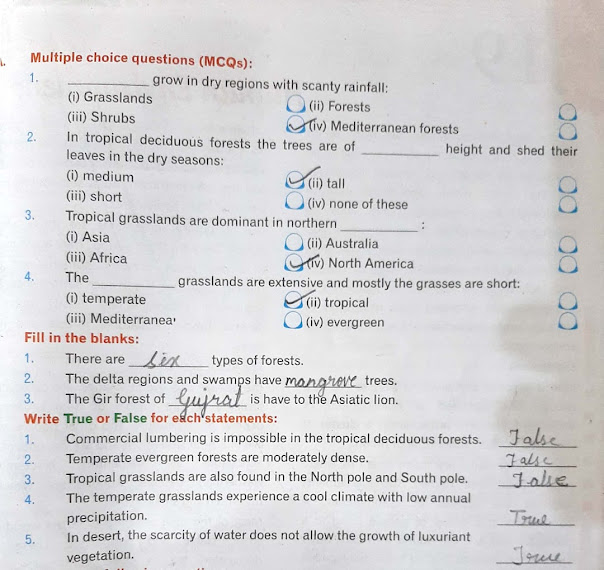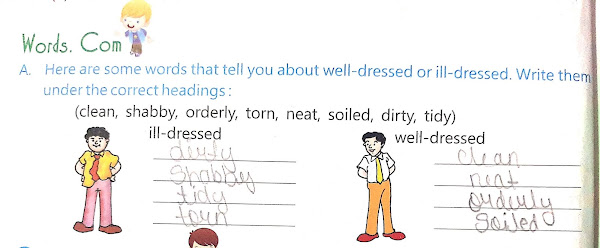EVENTS CONVENT HIGH SCHOOL
19/01/2021 CLASS-8 SLOT-2
SOCIAL SCIENCE(CIVIC)
CHAPTER -11 ECONOMIC DEVELOPMENT
_________________________________________________________________
A.Choose the most
suitable alternative:
Question 1.In India the total percent of working people in agriculture is:
(a) 50 percent
(b) 60 percent
(c) 70 percent
(d) None of the above
Answer:
(b) 60 percent
Question 2.The total contribution of agriculture in. Indian G.D.P. is:
(a) 26 percent
(b) 36 percent
(c) 42 percent
(d) 100 percent
Answer:
(a) 26 percent
Question 3.The industrial development:
(a) lessens dependence on agriculture
(b) improves life style
(c) Both of the above
(d) None of the above
Answer:
(b) improves life style
B. Fill up the blanks:
1.
India, Nepal, China, Pakistan are developing countries
and Japan, Singapore, Britain and U.S. are developed countries.
2.
The industrial development brings Prosperity for the
country and citizens.
3.
The modern iron and steel plant was set up At Porto-nova
in Tamil Nadu in 1830
4.
The cotton cloths from India are exported to prominent
countries U.S., Britain, Russia, France, Eastern Countries of Europe
5.
The slow pace of economy increases Poverty.
C.Very Short Answer Type
Questions
Question 1.What is poverty?
Answer:Poverty is the inability to secure minimum requirements of life, health and
efficiency. One is unable to get minimum requirements for life such as food,
clothing, housing, education and health due to poverty. Poverty leaves bad
effect on the life and health of man.
Question 2.What is unemployment?
Answer:Unemployment is a situation in which people are willing to work for income but
they are unable to find work.
Question 3.Which are mineral-based industries?
Answer:The industries based on raw material like iron, steel, cement, chemicals are
called mineral-based industry.
D.Short Answer Type Questions
Question 1.How was our economy in ancient times?
Answer:In the ancient times Indian economy was rich and developed. India was
independent in economy. The industry of pottery, metal, buildings were in
advanced stage during the Indus Valley Civilization. In the medieval time
Indian silk was in so high demand that Roman people were ready to give gold
equal to the weight of Indian silk, Indian trade of cotton, silk, cotton
clothes and spices was on the peak and our economy was rich in ancient times.
Question 2.What do you mean by small scale industry?
Answer:Cottage and small scale industries is the traditional industry as it needs
little money and goods are made by the family members. The farmers when they
have no work they earn money by this industry. These industries produce various
traditional products like baskets, small toys, bides, ropes, envelopes, papad,
mats, bade, spices and weaving items etc.
Question 3.What is sustainable agriculture?
Answer;Most of the farmers in India still use traditional tools for farming. They
cannot make use of refined seeds, fertilizers and pesticides due to’poor
economy and it also affects production. Their food production is consumed by
their family members.
Question 4.Write the names of Cottage industries.
Answer:Some of the Cottage industries are:Small toys making,Carpet weaving,Papad making,Basket making,Bidi making,Rope
making,Badi making,Mat weaving,Paper envelope making,Spices preparing etc.
Question 5.What is Gramin Rozgar Guarantee Programmer?
Answer:The Central Government has passed the “Gramin Rozgar Guarantee Yojna”
Bill, 2005. Under this bill a provision has been made to provide to one adult
person of every family a 100 days job in the periphery of 5 Km near his
residence. This scheme will be in force in 600 districts of the country by
2010.
E.Long Answer Type Questions
Question 1.How agriculture is helpful in economic growth?
Answer:The whole country depends on agriculture for its food requirements.
Through agriculture, we get cereals, vegetables and fruit; it also supplies raw
materials to various industries. Many industries, in India, depend on
agriculture for their raw material for example, jute, sugar, cotton, cotton
textile. Good crops raise the farmer’s income. With increase of income, the
farmers purchase various items of daily life manufactured in industry.
Agriculture is the backbone of our economic growth.
Question 2.Describe the mineral-based industry.
Answer:Such industries based on raw material like iron, steel, cement,
chemicals are called mineral-based industries. The first iron and steel plant
was set up at Porto nova in Tamil Nadu in 1830. Modern Iron and Steel plant was
set up in Jamshedpur in 1907. India has chemical industries under which
fertilizers, artificial fibers, rubber, plastic goods, paints and medicines are
made. Transport equipment like rail engine, motor cars, bus, truck, motorcycle,
aeroplane and ships industries have been set up in India. These industries
provide employments in large number to our people.













